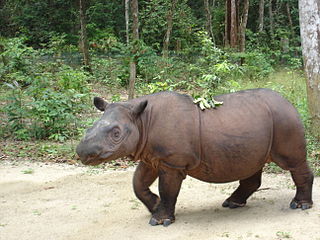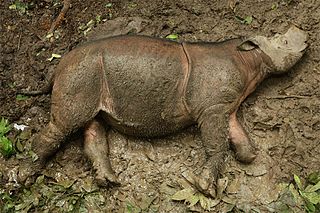
The San Diego Zoo Safari Park, originally named the San Diego Wild Animal Park until 2010, is an 1,800 acre zoo in the San Pasqual Valley area of San Diego, California, near Escondido. It is one of the largest tourist attractions in San Diego County. The park houses a large array of wild and endangered animals including species from the continents of Africa, Asia, Europe, North and South America, and Australia. This includes the largest collection of hoofed mammals in the world. The park is in a semi-arid environment, and one of its most notable features is the Africa Tram, which explores the expansive African exhibits. These free-range enclosures house such animals as antelopes, giraffes, buffalo, cranes, and rhinoceros. The park is also noted for its California condor breeding program.

African Lion Safari is a family-owned safari park in Southern Ontario, Canada, straddling the cities of Hamilton and Cambridge, located 100 kilometres (62 mi) west of Toronto. Guests may tour seven game reserves, with a total area of about 740 acres, on tour buses or in visitors' own vehicles, where animals roam freely in contained areas. Accompanying the game reserves is a walking section where exotic birds and primates, as well as the park's herd of Asian elephants, are on display.

The Sumatran rhinoceros, also known as the Sumatran rhino, hairy rhinoceros or Asian two-horned rhinoceros, is a rare member of the family Rhinocerotidae and one of five extant species of rhinoceros; it is the only extant species of the genus Dicerorhinus. It is the smallest rhinoceros, although it is still a large mammal; it stands 112–145 cm (44–57 in) high at the shoulder, with a head-and-body length of 2.36–3.18 m and a tail of 35–70 cm (14–28 in). The weight is reported to range from 500–1,000 kg (1,100–2,200 lb), averaging 700–800 kg (1,500–1,800 lb). Like both African species, it has two horns; the larger is the nasal horn, typically 15–25 cm (5.9–9.8 in), while the other horn is typically a stub. A coat of reddish-brown hair covers most of the Sumatran rhino's body.

Taronga Western Plains Zoo, formerly known as Western Plains Zoo and commonly known as Dubbo Zoo, is a large zoo near Dubbo, New South Wales, Australia. It opened to the public on 28 February 1977, to provide more living and breeding space for large animals such as elephants and antelopes which needed more space than was available at the restricted Sydney site. The zoo is run by the Taronga Conservation Society, along with Taronga Zoo Sydney. Western Plains Zoo is located on the Newell Highway in west Dubbo about 5 km from the city.

The Indian rhinoceros, or Indian rhino for short, also known as the greater one-horned rhinoceros or great Indian rhinoceros, is a rhinoceros species native to the Indian subcontinent. It is listed as Vulnerable on the IUCN Red List, as populations are fragmented and restricted to less than 20,000 km2 (7,700 sq mi). Moreover, the extent and quality of the rhino's most important habitat, the alluvial Terai-Duar savanna and grasslands and riverine forest, is considered to be in decline due to human and livestock encroachment. As of August 2018, the global population was estimated to comprise 3,588 individuals, including 2,939 individuals in India and 649 in Nepal. Kaziranga National Park alone had an estimated population of 2,048 rhinos in 2009. Pobitora Wildlife Sanctuary in Assam has the highest density of Indian rhinos in the world with 84 individuals in an area of 38.80 km2 (14.98 sq mi) in 2009.

Semen collection refers to the process of obtaining semen from human males or other animals with the use of various methods, for the purposes of artificial insemination, or medical study. Semen can be collected via masturbation, prostate massage, artificial vagina, penile vibratory stimulation (vibroejaculation) and electroejaculation. Semen can be collected from endangered species for cryopreservation of genetic resources.

Captive breeding, also known as captive propagation, is the process of keeping plants or animals in controlled environments, such as wildlife reserves, zoos, botanic gardens, and other conservation facilities. It is sometimes employed to help species that are being threatened by the effects of human activities such as climate change, habitat loss, fragmentation, overhunting or fishing, pollution, predation, disease, and parasitism.

The northern white rhinoceros or northern white rhino is one of two subspecies of the white rhinoceros. Formerly found in several countries in East and Central Africa south of the Sahara, this subspecies is a grazer in grasslands and savanna woodlands. Since 19 March 2018, there are only two known rhinos of this subspecies left, called Najin and Fatu, both of which are female; barring the existence of unknown or misclassified male northern white rhinos elsewhere in Africa, this makes the subspecies functionally extinct. The two female rhinos belong to the Dvůr Králové Zoo in the Czech Republic but live in the Ol Pejeta Conservancy in Kenya and are protected round-the-clock by armed guards.
Robert Hermes is a veterinarian researcher at The Leibniz-Institute of Zoo and Wildlife Research in Berlin. He studied veterinary medicine at the Freie Universität Berlin. He completed a Ph.D. in reproductive management.

The Cheetah Conservation Fund is a research and lobby institution in Namibia concerned with the study and sustenance of the country's cheetah population, the largest and healthiest in the world. Its Research and Education Centre is located 44 kilometres (27 mi) east of Otjiwarongo. The CCF was founded in 1990 by conservation biologist Laurie Marker who won the 2010 Tyler Prize for her efforts in Namibia.

Orana Wildlife Park is New Zealand's only open-range zoo, sitting on 80 hectares of land, located on the outskirts of Christchurch. It opened in 1976, and is owned and operated by the Orana Wildlife Trust, a registered charity. The aims of the Trust are to provide quality recreational opportunities for local people and visitors to Christchurch; conserve endangered native and exotic wildlife; educate visitors about environmental and conservation issues; and support research relating to endangered animals.

Fossil Rim Wildlife Center is a 501(c)(3) non-profit conservation center near Glen Rose, Texas. They specialize in the breeding of endangered species, public education, scientific research and natural land management. The facility has over 1,000 animals from 50 species. Guests have access to guided and self-guided tours across the center's 1800 acres of Texas Hill Country, as well as lodging, dining and educational facilities.
Francesco Romano Nardelli is an Italian naturalist who has dedicated his life to the protection and conservation of endangered species. He is also the co-founder, with John Aspinall, of the Sumatran Rhino Project, one of the most important coordinated efforts to save a critically endangered species.

JoGayle Dillon Howard was an American zoologist and theriogenologist specializing in the captive breeding of endangered species such as pandas, clouded leopards, and black-footed ferrets.
Manor House Wildlife Park is a 52-acre (21 ha) zoo located in Pembrokeshire, Wales, just north of the village of St Florence. It was bought in 2008 by television presenter Anna Ryder Richardson and Colin MacDougall and is more recently known as Manor Wildlife Park.
Rebecca Spindler is the head of science and conservation at non-profit conservation organisation Bush Heritage Australia. She previously was the manager of research and conservation at Taronga Conservation Society Australia, in the New South Wales Office of Environment and Heritage (OEH).

Angalifu was a captive northern white rhinoceros held at the San Diego Zoo Safari Park. At the time of his death, he was one of six living northern white rhinoceroses in the world, one of two living males in the world, and the only male on the American continents. He was outlived by male Sudan and females Najin and Fatu.
Justine K. O'Brien, an Australian zoologist, is best known for her use of reproductive research to assist in wildlife management and conservation.

The Bornean rhinoceros, also known as the eastern Sumatran rhinoceros or eastern hairy rhinoceros, is one of three subspecies of Sumatran rhinoceros. The subspecies may be functionally extinct, with only one individual, a female named Pahu, surviving in captivity, and held in the state of Sabah. In April 2015, the Malaysian government declared the Bornean rhinoceros to be extinct in the wild in the Malaysian portion of Borneo. However, in March 2016, a young female rhino was captured in East Kalimantan, providing evidence of their continued existence. The International Union for Conservation of Nature (IUCN) classifies the subspecies as critically endangered.
David Edwin Wildt was an American wildlife biologist, who worked at the Smithsonian Institution's National Zoo and Conservation Biology Institute (SCBI) for almost 40 years. He pioneered research in wildlife reproductive physiology, and became instrumental in rescuing species which would have otherwise gone extinct due to dwindling population sizes. The species he may have helped "save" from extinction included cheetahs, lions, African antelopes, black-footed ferrets, while his work included first time artificial inseminations of the clouded leopard, puma, snow leopard, tiger, Eld's deer, scimitar-horned oryx, Persian onager, and the Przewalski's horse.













